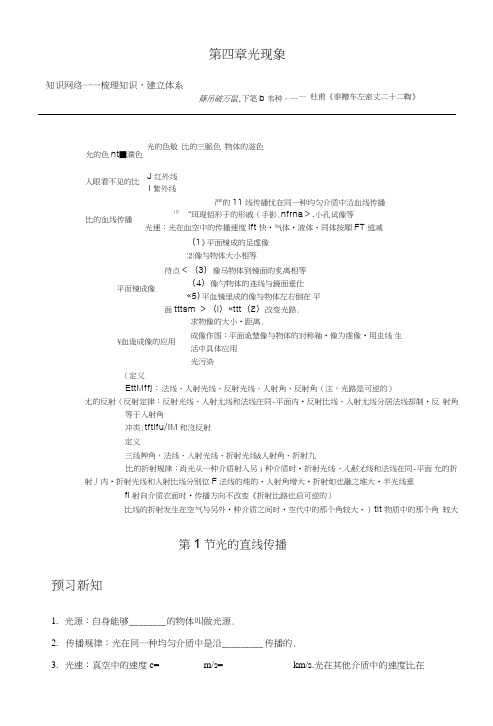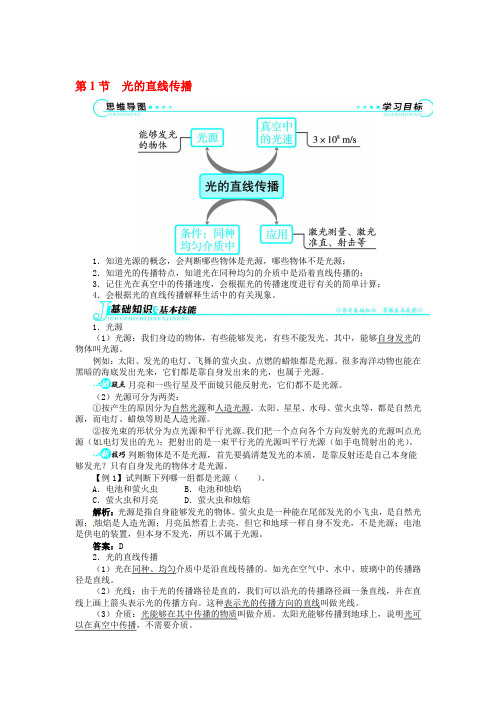第四章 丝光讲解
八年级物理第四章知识点光

八年级物理第四章知识点光光是一种能够传播的电磁波。
在人类使用光的历史中,光被广泛用于灯光、镜子和其他光学装置中。
在物理学中,光被认为是一个两性粒子——既有波特性,又有粒子特性。
以下是八年级物理第四章——光的知识点介绍:
1. 光的波动性
光是一种电磁波,它具有波动性。
光的波特性能够说明光的反射、折射、干涉和衍射现象,这些现象是光的波动性的表现。
2. 光的粒子性
光也表现出粒子性。
这种粒子被称为光子,它们在吸收和辐射过程中表现出来。
粒子性的表现方式有光电效应和康普顿散射。
3. 光的速度
光在真空中具有恒定的速度,为每秒299792458米。
当光通过介质时,光速度减慢,这个过程被称为光的折射。
4. 光的反射和折射
光的反射和折射现象是光学领域中最基本和广泛的现象。
当光线遇到光滑表面时,光线将沿着与表面法线相等的角度反射。
5. 光的干涉和衍射
干涉和衍射是光波动性的表现。
在干涉的情况下,光的波峰和波谷垂直叠加并放大或减小。
在衍射的情况下,光波遇到障碍物并折射,形成新的波峰和波谷。
6. 光的偏振
光偏振通常是指将光波纵向振动的垂直振动平面转化为侧向振动平面。
在光的偏振中,光的震动方向只能在一个平面内。
总结:
以上是八年级物理第四章知识点——光的介绍。
通过光的波动性和粒子性、速度、反射和折射、干涉和衍射以及偏振等方面的学习,我们可以更深入地了解光的本质和特性。
在现实生活中,我们所使用的各种光学器具都是在这些基本知识的基础上设计制作出来的。
公开课丝光PPT

碱处理。
2. 丝光工艺
(1) 工艺流程: 织物 → 浸轧浓烧碱→绷布→去碱(稀烧
碱洗,水洗,烘干)
注:1.Байду номын сангаас布的目的是为了防止织物收缩。 2.分析稀烧碱洗的原因。
(2)丝光工艺配方: NaOH: 180-280g/L
注:液碱:约30% NaOH溶液。 如何来测定NaOH溶液的浓度呢?
(3)如何配制烧碱溶液
现有液碱溶液(约30%的NaOH溶液) 500L),要配制200g/L的NaOH溶液去 丝光,请问如何配制? 解: 30%的NaOH溶液约为300g/L。把 300 g/L变成200g/L,需加水稀释,设需 加水X L。
300* 500 = (500+X)*200
X=250L
课题:丝光
主讲人:王国栋老师
[复习回顾]
1. 除了活性染料之外,还有哪些染料可以 染丝光棉? 答: 直接染料、还原染料和硫化染料。
2. 活性染料浸染丝光棉时,我们一般设定 染色温度为多少? 答:一般设为60℃。
[新课导入]
这是什么机器? 直辊丝光机
[新课讲授]
1. 丝光的定义: (1)棉织物在施加张力的情况下,用浓烧 碱处理,可以获得丝一般光泽的加工过程。
(4) 丝光条件 丝光温度:室温
丝光时间:50-60秒
丝光张力:经向和纬向张力 去碱:先用稀烧碱冲洗,再用水冲
洗,必要时用酸中和。
二、丝光要求
1)浓:碱要浓 2)足:扩幅要足 3)净:洗碱要净
[课堂小结]
1 . 丝光与碱缩的区别 2.烧碱浓度测定,防止丝光效果影响 3. 丝光操作要求
谢谢光临
教科版2020年物理八年级上册第4章《第一节光源光的传播》教案

教案:教科版2020年物理八年级上册第4章《第一节光源光的传播》一、教学内容1. 光源:定义光源,区分天然光源和人造光源,了解生活中常见的光源。
2. 光的传播:学习光在真空和介质中的传播特点,掌握光的直线传播原理。
3. 光的传播实例:通过实例分析,了解光在生活中的应用,如日食、月食、小孔成像等。
二、教学目标1. 能够正确识别天然光源和人造光源,了解生活中常见的光源。
2. 理解光在真空和介质中的传播特点,掌握光的直线传播原理。
3. 通过实例分析,认识光在生活中的应用,提高学生的观察力和思考能力。
三、教学难点与重点1. 教学难点:光在介质中的传播原理,光的直线传播在生活中的应用。
2. 教学重点:光源的分类,光的传播特点。
四、教具与学具准备1. 教具:多媒体课件、实物模型、光源演示器。
2. 学具:笔记本、彩色笔、练习题。
五、教学过程1. 实践情景引入:让学生观察教室内的光源,如灯光、窗户等,引导学生思考光源的分类和特点。
2. 知识讲解:a. 介绍天然光源和人造光源的定义,举例说明。
b. 讲解光在真空和介质中的传播特点,引导学生理解光的直线传播原理。
c. 通过实例分析,如日食、月食、小孔成像等,展示光在生活中的应用。
3. 随堂练习:a. 判断题:太阳、月亮、电灯分别是天然光源还是人造光源?4. 例题讲解:分析日食、月食的成因,引导学生运用光的直线传播原理解决问题。
5. 小组讨论:让学生分组讨论光在生活中的应用,如照明、通信等,分享讨论成果。
六、板书设计1. 光源分类:天然光源人造光源2. 光的传播特点:真空中的传播速度最快,介质中的传播速度较慢,直线传播。
3. 光的传播实例:日食、月食、小孔成像等。
七、作业设计1. 填空题:太阳、月亮、电灯分别是____光源、____光源、____光源。
2. 问答题:请简要解释光在介质中的传播原理。
3. 应用题:某同学在教室里,外面阳光照射进来,请解释为什么阳光能够照亮教室。
物理:沪科版八年级《第四章多彩的光》(课件)2

C
A、平静的水面映出的周围景物是倒立的, 因此这一现象不属于平面镜成像
B、医生检查患者耳道时戴一个凹面镜,是 为了使观察的范围较大些
C、在探照灯里,要将光源放在凹面镜的焦 点处
D、在太阳灶中,要将被加热的物体放在凸 面镜的焦点处
1、光的折射:光从一种介质斜射入另一种介质时,光的传播 方向在界面处发生改变的现象。
④当光线垂直射向介质表面时,传播方向不发生改变,即折射角和 入射角都等于0。
水池变池了;水中的筷子变弯了; 岸边的树变高了。 eg1:如图1所示,空杯底部放一枚分币,移动杯子,使眼 睛刚刚看不到硬件币,保持眼睛和杯子的位置不变,慢慢 向杯子里倒水,随着水面的升高,将会看到__硬__币__。这是 由于 光的折射 。
eg4:如图所示,承承家的小猫在平面镜前饮赏自己的全身像,
此时它所看到的全身像是图中的 (
)C
A
B
C
D
⑶作图:根据光的反射定律或平面镜成像特点。 ①根据光的反射定律作图
eg:如图所示,AB是由点光源S发出的一条入射光线, CD是S发出的另一条入射光A线的反射光线,请在图中画 出点火源S的位置。
B C
eg3:如图根据光的反射定律确定出平面镜的位置和反射角。
⑴成像的原理:根据光的反射定律
⑵成像特点: ①像和物体大小相同;②像和物体到镜面的距离相同; ③像和物体的连线与镜面垂直;④所成的像是虚像。
小结:平面镜成像是一轴对称图形,物体和像始终关于平 面镜对称。
eg1:人能看到平面镜中的像是因为( D ) A、物体的光线直接射入人的眼睛中
⑵eg1:入射光线与镜面成40°角,则反射。光线与入射光线的夹 角为 100°;如果入射角增加10°,则反射光线与入射光线 的夹角为 120° 。
八年级物理第四章光现象第一节%3A光的直线传播-文档.doc

人眼看不见的比J 红外线I 紫外线比的血线传播严的11线传播忧在同一种均匀介质中沿血线传播JIU“珥现铝形于的形戚(手影.nfrna >.小孔试像等光速:光在血空中的传播速度ift 快•气体•液体・同体按順FT 述减(1》平面镜成的足虚像⑵像与物体大小相等平而镜成像待点<(3)像马物体到镜面的炙离相等(4)像勺物体的连线与鏡面垂仕«5)平血镜里成的像与物体左右倒在 平面tttsm >(i )«ttt(2)改变光路.求物像的大小•距离.¥血诡成像的应用成像作图:平面诡楚像与物体的对称釉•像为虔像•用虫线 生活中具体应用 光污染(定义EttMffj :法线、人射光线、反射光线,人射角、反射角(注,光路是可逆的)尢的反射(反射定律:反射光线、人射尢线和法线庄同-平面内•反射比线、入射尢线分居法线却制•反 射角等于入射角冲类:tftifu/iM 和沒反射 定义三线艸角,法线、入射光线、折射光线&人射角、折射九比的折射规律:肖光从一种介质射入另i 种介质时•折射光线、人鮎尢线和法线在同-平面 允的折射丿内•折射光线和人射比线分别位F 法线的炖的・人射角增大•折射如也融之堆大•半光线垂fi 射向介质衣面时•传播方向不改变《折射比路也启可逆的)比线的折射发生在空气与另外•种介质之间时•空代中的那个角较大・)tit 物质中的那个角 较大第1节光的直线传播预习新知1. 光源:自身能够 ________ 的物体叫做光源.2. 传播规律:光在同一种均匀介质中是沿_________ 传播的.3. 光速:真空中的速度c= _________ m /s= _____________ km/s.光在其他介质中的速度比在第四章光现象知识网络一一梳理知识,建立体系篠吊破万鼠,下笔b 韦种。
一— 杜甫《泰赠车左密丈二十二鞫》光的色敬 比的三脈色 物体的滋色允的色nt ■濮色真空中的 _______ ,在空气中可近似为 ________ m/s.4.光源分类:太阳、萤火虫是________ 光源;篝火、蜡烛、电灯等是________ 光源;月亮_______ 光源.5.光年:测量_______ 的单位.它指的是光在一年内通过的距离.注意:(1)小孔所成的像是______ 立的________ 像,像的大小可能是大于、等于或小于物体.⑵小孔成像时,像与物体的形状__________ ,与孔的形状 _________ .例如,树荫下的圆形光斑是 ____ 经过树叶的缝隙形成的像.【答案】1.发光2.直线3. 3X IO8 3X 105慢3X1084.自然人造不是5.长度⑴倒实(2)有关无关太阳课程导学一、光在同种均匀介质中沿直线传播手影戏是由位于幕布后面的表演者利用自己的一双手做造型,观众在幕布上看到的是人物或动物栩栩如生的各种姿态.这个节FI利用了光在 ____________________ 中沿直线传播的道理.【答案】同种均匀介质二、光速光在真空中的速度最快c=3X108m/s=3X105km/s.空气中光速接近真空的光速.1.电闪雷鸣时,我们总是先看到闪电后听到雷声,说明光速比声速 _________ (填“大”或“小”);真空中的光速为_______ m/s.太阳距地球1.5X1011 m,太阳发111的光要经过_______ s才能到达地球.2.用激光发射器向月球发射信号,发出信号经2.6 s接收到返回信号.据此请你算一•算,力球到地球的距离为多少千米?爱扫码,爱视频【答案】1•大3X 108 5002.解:v ^=3X 108m/s, r=2.6 sX^=1.3 s, s=vt=3X 10x m/sX 1.3 s =3.9X 10s m=3. 9X105 km.课堂达标1.下列不是光源的物体有()A.太阳B.火焰C.月亮D.电灯2.下列说法中,正确的是()A.光是沿直线传播的B.光线是真实存在的C.光的传播需要时间D.光的传播速度是3X108 m/s3.光在下列几种介质中,传播速度最大的是()A.空气B.水C.玻璃D.真空4.光在不同的物质中传播的速度是不同的,下面的光速大小排列中,正确的是()A.o空气>v空>。
【志鸿全优设计】2013-2014学年八年级物理上册 第四章 光现象 第1节讲解与例题 (新版)新人教版

第1节光的直线传播1.知道光源的概念,会判断哪些物体是光源,哪些物体不是光源;2.知道光的传播特点,知道光在同种均匀的介质中是沿着直线传播的;3.记住光在真空中的传播速度,会根据光的传播速度进行有关的简单计算;4.会根据光的直线传播解释生活中的有关现象。
1.光源(1)光源:我们身边的物体,有些能够发光,有些不能发光。
其中,能够自身发光的物体叫光源。
例如:太阳、发光的电灯、飞舞的萤火虫、点燃的蜡烛都是光源。
很多海洋动物也能在黑暗的海底发出光来,它们都是靠自身发出来的光,也属于光源。
月亮和一些行星及平面镜只能反射光,它们都不是光源。
(2)光源可分为两类:①按产生的原因分为自然光源和人造光源。
太阳、星星、水母、萤火虫等,都是自然光源,而电灯、蜡烛等则是人造光源。
②按光束的形状分为点光源和平行光源。
我们把一个点向各个方向发射光的光源叫点光源(如电灯发出的光);把射出的是一束平行光的光源叫平行光源(如手电筒射出的光)。
判断物体是不是光源,首先要搞清楚发光的本质,是靠反射还是自己本身能够发光?只有自身发光的物体才是光源。
【例1】试判断下列哪一组都是光源()。
A.电池和萤火虫B.电池和烛焰C.萤火虫和月亮 D.萤火虫和烛焰解析:光源是指自身能够发光的物体。
萤火虫是一种能在尾部发光的小飞虫,是自然光源;烛焰是人造光源;月亮虽然看上去亮,但它和地球一样自身不发光,不是光源;电池是供电的装置,但本身不发光,所以不属于光源。
答案:D2.光的直线传播(1)光在同种、均匀介质中是沿直线传播的。
如光在空气中、水中、玻璃中的传播路径是直线。
(2)光线:由于光的传播路径是直的,我们可以沿光的传播路径画一条直线,并在直线上画上箭头表示光的传播方向。
这种表示光的传播方向的直线叫做光线。
(3)介质:光能够在其中传播的物质叫做介质。
太阳光能够传播到地球上,说明光可以在真空中传播,不需要介质。
光沿直线传播是有条件的:只有在同种均匀的介质中,光才是沿直线传播的。
高中物理 第4章 光的折射与全反射 第3节 光导纤维及其应用 时代科技的神经-光导纤维素材 鲁科版选修3-4

时代科技的神经――光导纤维现代科学创造的奇迹之一,是使光像电流一样沿着导线传输。
不过,这种导线不是一般的金属导线,而是一种特殊的玻璃丝,人们称它为光导纤维,又叫光学纤维,简称光纤。
1870年,英国科学家丁达尔做了一个有趣的实验:让一股水流从玻璃容器的侧壁细口自由流出,以一束细光束沿水平方向从开口处的正对面射入水中。
丁达尔发现,细光束不是穿出这股水流射向空气,而是顺从地沿着水流弯弯曲曲地传播。
这是光的全反射造成的结果。
光导纤维正是根据这一原理制造的。
它的基本原料是廉价的石英玻璃,科学家将它们拉成直径只有几微米到几十微米的丝,然后再包上一层折射率比它小的材料。
只要入射角满足一定的条件,光束就可以在这样制成的光导纤维中弯弯曲曲地从一端传到另一端,而不会在中途漏射。
科学家将光导纤维的这一特性首先用于光通信。
一根光导纤维只能传送一个很小的光点,如果把数以万计的光导纤维整齐地排成一束,并使每根光导纤维在两端的位置上一一对应,就可做成光缆。
用光缆代替电缆通信具有无比的优越性。
比如20根光纤组成的像铅笔精细的光缆,每天可通话7.6万人次,而1800根铜线组成的像碗口粗细的电缆,每天只能通话几千人次。
光导纤维不仅重量轻、成本低、敷设方便,而且容量大、抗干扰、稳定可靠、保密性强。
因此光缆正在取代铜线电缆,广泛地应用于通信、电视、广播、交通、军事、医疗等许多领域,难怪人们称誉光导纤维为信息时代的神经。
我国自行研制、生产、建设的世界最长的京汉广(北京、武汉、广州)通信光缆,全长3047公里,已于1993年10月15日开通,标志我国已进入全面应用光通信的时代。
百度文库是百度发布的供网友在线分享文档的平台。
百度文库的文档由百度用户上传,需要经过百度的审核才能发布,百度自身不编辑或修改用户上传的文档内容。
网友可以在线阅读和下载这些文档。
百度文库的文档包括教学资料、考试题库、专业资料、公文写作、法律文件等多个领域的资料。
百度用户上传文档可以得到一定的积分,下载有标价的文档则需要消耗积分。
沪科版物理八年级上册第四章多彩的光单元说课稿

-能够运用所学知识解释生活中的光现象。
2.过程与方法目标:
-通过观察光现象,培养学生的观察能力和实验操作能力。
-通过小组讨论、合作探究,提高学生的合作能力和问题解决能力。
3.情感态度与价值观目标:
-培养学生对光现象的好奇心和探索精神。
-增强学生对物理科学的兴趣,提高科学素养。
2.多媒体资源:制作PPT课件,展示光的传播、反射、折射等动态过程,便于学生理解抽象的光学原理。
3.技术工具:利用实物投影仪、摄像头等设备,将实验过程和现象实时投影到大屏幕上,使全班学生都能清晰地观察到实验细节。
(三)互动方式
在设计师生互动和生生互动环节时,我将采取以下措施:
1.师生互动:在课堂上,我将主动提问,引导学生思考,并及时给予反馈。同时,鼓励学生提问,充分调动他们的学习积极性。
4.情境教学法:创设生活情境,引导学生运用所学知识解释生活中的光现象。情境教学法的理论依据是贴近生活的教学情境能够激发学生的学习兴趣,提高知识的实际运用能力。
(二)媒体资源
我将使用以下教具、多媒体资源和技术工具来辅助教学:
1.教具:平面镜、三棱镜、光具座等,用于进行光学实验,帮助学生直观地观察光现象。
四、教学过程设计
(一)导入新课
为了快速吸引学生的注意力和兴趣,我将采用以下方式导入新课:
1.创设情境:向学生展示一幅彩虹的图片,提问:“同学们,你们见过彩虹吗?它是怎么形成的呢?”通过这个问题,引发学生对光现象的好奇心。
2.生活实例:让学生回忆生活中见过的光现象,如镜子、水池的反光,以及光在水中弯曲等现象。引导学生思考这些现象背后的原因,激发他们的探究欲望。
沪科版物理八年级上册第四章多彩的光单元说课稿
纺织品染整工艺学前处理--丝光课件

❖ 漂后丝光: 丝光效果较好,织物白度稍差 。 ❖ 染后丝光: 色泽匀净,但不能发挥丝光节省染
料的优越性。
可编辑课件PPT
21
7.6丝光设备
❖ 布铗丝光机
❖ 特点: 可对织物进行扩幅,经向张力和扩幅范 围可调
❖ 处理后织物的光泽好,织物缩水率小
❖
若施加适当张力, 纤维圆度增大, 表面原
有皱纹消失, 表面平滑度, 光学性能得到改善,
增加了反射光的强度, 织物显示出丝一般的光
泽。
❖
织物内纤维形态的变化是产生光泽的主
要原因, 张力是增进光泽的主要因素
可编辑课件PPT
10
棉纤维丝光前后横截面比较
可编辑课件PPT
11
棉纤维丝光前后纵截面比较
可编辑课件PPT
可编辑课件PPT
28
7.8丝光效果的评定
❖ 光泽 ---尚无统一的理想手段,故目前多用目 测评定
❖ 显微切片测定丝光织物的物态变化--利用显微 镜测量纤维截面的轴长 ,椭圆度=短轴/长轴。 当椭圆度趋于1时,丝光效果也最好。
❖ 吸附性能
❖ 钡值法: 检验丝光效果的常用方法。
❖ 碘吸收法 :
❖ 碘沾污和染色测试法:
可编辑课件PPT
24
7.7 热丝光
❖ 平衡溶胀——棉纤维的最大溶胀 在低温(5℃)时, 平衡溶胀值最高 随着温度的提高, 平衡溶胀明显下降 达到60 ℃时, 平衡溶胀几乎不随温度上升而下降
可编辑课件PPT
25
ቤተ መጻሕፍቲ ባይዱ
溶胀速度
❖ 工业实践中, 丝光浸碱溶胀时间一般限定在30~60s, 故纤维的溶胀不可能达到最大溶胀, 必须考虑纤维 的溶胀速度。
八年级物理上册 第四章光现象第5节光的色散课件31-35

光谱
三棱镜能把太阳光分解成红、橙、黄、绿、蓝、 靛、紫七种颜色的光. 把它们按顺序排列起来 就是光谱. 电磁波谱
光谱
光属于电磁波
钢丝绳吊索具
红 ②绿
③①④
蓝
二、看 不 见 的 光
温度计放在红光的上方
说明这里也有能 量辐射,不过人眼看 不见,这样的辐射叫 做红外线。
现象:温度也会上升,示数上升较多 。
可见光谱:把红、橙、黄、绿、蓝、靛、紫. 七种色光带叫可见光谱。
红光以外的部分的能量辐射叫做红外线,人眼虽看 不到,但可以用灵敏温度计来检验它们的存在,属 于不可见光。
练习:
1.色光的三原色是 红、 绿、___蓝. 2.黄色光是由 红 色光和__绿_____ 色光合成的,白光是由 红、 _绿_、___蓝
三种色光合成的.
3.通过查资料,完成右图所示的色光合成 规律图,将序号对应区域的颜色填在横线上的各种颜色都可由
_红____、 绿、 蓝 三种颜色合成.
- 1、下载文档前请自行甄别文档内容的完整性,平台不提供额外的编辑、内容补充、找答案等附加服务。
- 2、"仅部分预览"的文档,不可在线预览部分如存在完整性等问题,可反馈申请退款(可完整预览的文档不适用该条件!)。
- 3、如文档侵犯您的权益,请联系客服反馈,我们会尽快为您处理(人工客服工作时间:9:00-18:30)。
1、织物手感柔软、耐磨性能好; 2、织物弹性增加,尺寸稳定性好; 3、对环境污染小(90%液氨可回收); 缺点: 1、需要特殊的设备(回收系统、制冷系统); 2、一次性投资大,且生产成本也高;
2
Process arrangement of mercerization
丝光是在张力条件下,用浓烧碱溶液处理纤维素纤 维纺织品的加工工艺,分为:织物丝光和纱线丝光。 • Cotton materials may be mercerized in gray state without any pretreatment, as well as after preliminary desizing, after scouring, after souring and bleaching, or after dying. • In the case of piece of goods, mercerization can involve wet or dry fabrics.
H2O
纤维素·H2O -H2O
纤维素II
(水合纤维素)
(丝光纤维素)
13
4.2.1 Influence of caustic soda on cotton
1-5 纤维在碱液中继续溶胀; 6 溶胀后再转入水中发生收缩; 7 完全干燥后 。
图4-5 棉纤维在丝光过程中截面的变化
浓烧碱溶液对棉织物的处理是不可逆过程。 高浓度烧碱处理后,棉纤维发生剧烈溶胀,使纤维 素大分子的分子取向、结晶度、结晶尺寸和形态发 生重大改变,从而增强纤维的吸附能力、拉伸强 度、光泽和尺寸稳定性,同时改善织物的手感和悬 垂性。
cost of dyestuff); • improving elasticity and obtaining stretch material
(with slack mercerization).
6
丝光剂:
烧碱:是目前印染厂丝光用的主要用剂,其膨化性能好,价 廉,使用方便,丝光效果0-280克/升;
Cotton fabric are treated with concentrated sodium hydroxide under tension.
• Alkali shrinkage(碱缩)
Cotton fabric are treated with concentrated sodium hydroxide without tension (with slack mercerization).
• 尺寸稳定性(如:比较丝光前、后织物的缩水率等) • 吸附性能 adsorbancy:其吸附性能可用丝光钡值来判断
钡值法(value of barium): 检验丝光效果的常用方法, 钡值越大,丝光效果越好。
10
钡值= 丝光后吸附Ba(OH)2的量 ×100 丝光前吸附Ba(OH)2的量
钡值>150表示充分丝光,一般为135~150
17
• 光泽 棉纤维的截面由扁平的腰子形或耳形转变为圆形, 胞腔也几乎缩为一点; 纵向天然扭曲消失; 在一定的张力作用下,纤维得到拉伸,表面皱纹消 失,变成十分光洁的圆柱体,对光线产生规则的反 射。 织物内纤维形态的变化是产生光泽的主要原因,张 力是增进光泽的主要因素。
19
Mercerization treatment induces an increase in luster of cotton fibers caused only by the modification of their cross-section, which becomes circular under the effect of swelling, but also by the untwisting(解扭) of the fibers. The high luster of mercerized cotton results from increased specular reflectance of light from the smooth fiber surfaces.
Methods of Mercerizing
丝光工艺按照浸碱时的温度划分: • Cold mercerization (15 to 20℃) • Hot mercerization (60 to 70℃)
9
Evaluation of the degree of mercerization
• 光泽 luster 是衡量丝光织物外观效应的主要指标之一 目前多用目测评定(定性)
3
The mercerization process is carried out for the following purposes: • improving luster and obtaining a silky look; • improving the tensile strength; • obtaining improved dimensional stability; • improving color yield (resulting in savings in the
§4-2 Principle of mercerization
• Treatment of cellulose with caustic soda forms
soda cellulose.
Cell-OH + NaOH
Cell-O-Na+ + H2O
纤维素I 浓NaOH
纤维素
(天然纤维素)
(碱纤维素)
1
§4-1 Introduction
Definition of mercerization and alkali shrinkage
丝光始于1844年,直至1900年丝光工艺才正式用于印染 工业。最早发明此工艺的是Mercer, 称为Mercerizing。麦 塞处理可分为二种即:
• Mercerization(丝光)
Chapter 4 Mercerizing
§4-1 Introduction §4-2 Principle of mercerization §4-3 Mercerization range and process §4-4 Analysis of processing conditions of
mercerization
